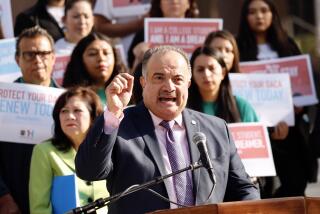New Skipper Charts Course for College
Enrollment at Miramar College this semester is up 20% from spring, to more than 8,000 students, with upwards of 30,000 expected within a decade.
A new policy academy, a permanent classroom building, a permanent library, a remodeled administration building, and a large park and playing fields are all under construction as part of a $33-million expansion. A tripling of the permanent faculty, now numbering 30 professors, is planned in the next three years.
Enter Jerome Hunter, the newly named president of the sprawling 105-acre campus along the Interstate 15 corridor. The 43-year-old educator will play a critical role in shaping the future as the campus embarks on a major expansion of not only its physical plant but its academic offerings to the growing communities of Mira Mesa, Scripps Ranch, Tierrasanta, Poway, and Rancho Penasquitos.
The image of Miramar will depend in large measure on how Hunter works with an anxious but eager faculty, on how he meshes Miramar’s traditional emphasis on vocational courses with newer academic core offerings and how he develops its role as a community and cultural locus for North City.
“I like the area, you can see all the change taking place,” Hunter said last week after his first extensive visit to the area, which included the ground breaking for the park and recreation complex being developed jointly with the city of San Diego. He officially takes the reigns Oct. 2 at Miramar, long the odd college out among the three campuses of the San Diego Community College District. (Mesa and City are the other two comprehensive campuses.)
Gratifying Reception
“I’ve been pleased with my reception, and especially by the commitment to improving this institution by the faculty,” he said.
The president of the academic senate, political science instructor Robert Bacon, said that Hunter “most definitely will have my support and that of the senate,” even though he was not the first choice of a campus search committee earlier this year.
“In many ways, he is ideal for our campus,” said Bacon. “We wanted a people person, and he is just that; we wanted a person who will relay campus concerns to the district office, and he is most articulate, young and energetic for that.”
Where the faculty at first expressed some doubts was with Hunter’s extensive background in continuing education, as dean of that division for a new campus in the Rancho Santiago college district in Santa Ana, at a time when Miramar will be expanding into a comprehensive college with stronger links to four-year campuses such as San Diego State University and UC San Diego.
“But, the more we think about it, his ability in building a campus (from scratch) in Orange County may put us on solid ground in this third area as well,” said Bacon, referring to Hunter’s successful development of the continuing education center for Rancho Santiago.
Hunter considers himself well-prepared for the Miramar position, citing his own work not only as a political science instructor and dean, but in private industry as an aerospace buyer and construction planner.
He also has enjoyed a strong working relationship with Bill Wenrich, now the chancellor of the San Diego district, when Wenrich served as Hunter’s dean at Rancho Santiago when Hunter was a counselor.
“I think he influenced me a lot, and it is important to be comfortable with the person to whom you are going to report to,” Hunter said. “Wenrich is a plain-vanilla type of person, as simple as it sounds, and I think my own style is similar.
“I am not abusive, I am open to recommendations, and I believe in the truth, whether it scrapes or slides.”
Wenrich has no reservations about Hunter’s selection, saying that the new president “has the charisma and the ability to provide the visionary leadership that both I and the board (of trustees) want at Miramar . . . the beauty is that Miramar has so many options for itself because of the growth that is occurring, and Jerry has the background across the board to do the quality leadership.”
Hunter, a native of Birmingham, Ala., came to Southern California while in high school under the sponsorship of a Unitarian Church minister offering to take the teen-ager away from the unrest and confrontation over Birmingham school desegregation in the early 1960s.
He later worked his way through Santa Ana College, moving on for a bachelor’s degree from UC Riverside, a master’s from Occidental College and a doctorate from USC.
Although Hunter has asked more questions than he has given answers during his first campus visits, he already has an idea of where he and the faculty should concentrate at first.
Hunter will look at revising the present master plan, completed in 1977 when the vision for Miramar projected a vocational educational center. He wants to be certain that planned uses for the many buildings now under construction or in the final blueprint stage reflect the future campus needs and direction. Those now include a mixture of academic courses, classes for immigrants and the nearby Miramar Naval Air Station, as well as the traditional vocational training long offered at the campus.
The campus is within a few miles of the county’s three largest high schools in enrollment--Mira Mesa, Poway and Mt. Carmel--and graduates in those areas are increasingly looking to Miramar as an academic alternative to SDSU or other institutions.
Hunter also wants nearby communities to look toward Miramar as a community resource. He envisions not only their use of Miramar’s planned recreational facilities--to include an indoor pool and a modern gymnasium--but also cultural facilities such as a theater for arts groups.
“I’ve already mentioned this to the chancellor because the performing arts can pull people onto a campus and be a real contribution to all students as well,” Hunter said.
But, even in the short-term, Hunter believes that Miramar can compete successfully in the community college marketplace.
If a potential student should ask Hunter why he should attend Miramar, given all the construction and growing pains, Hunter said he would point to the “intimate way the faculty works with students, that learning is more than steel or glass.
“The first time I ever came down here, no one knew who I was, yet everyone was warm and friendly . . . and that positive feeling can be a key to positive learning.”
More to Read
Sign up for Essential California
The most important California stories and recommendations in your inbox every morning.
You may occasionally receive promotional content from the Los Angeles Times.










